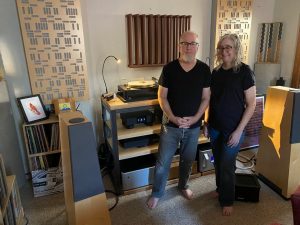Hans Ole Vitus Nielsen with his latest SIA-030 amp, next to the High Fidelity reference system
Hans Ole Vitus Nielsen, usually called Hans Ole, known for his surname—Vitus (it will become clear at the end of the interview), is the founder, owner and main engineer of the Vitus Audio company. It is one of the most important high-end world manufacturers, with a seat in the Danish city of Herning. The company was set up in 1995, but it presented its first three products in the year 2003: the battery-powered RP-100 phono stage, the RL-100 line preamp and the SM-100 power amp in the form of monoblocks.
Vitus Audio specializes in amplifiers, but it also offers perfect digital-to-analogue converters and Compact Disc players. During the High End 2019 exhibition in Munich, the company presented its latest product, the SIA-030 integrated amplifier having a characteristic orange anodized finish. As Hans Ole says, it is his most important product in years—one that starts a new generation of Vitus Audio devices. The device weighs 65 kg and it is quite small. It operates in two modes: 30 Wpc class A or 200 Wpc class AB.
Our sticker on the glass of the Vitus Audio company room (High End 2019)
We talked about the new amplifier, problems that contemporary industry poses for manufacturers and ways of solving them at my home in the second half of September. The SIA-030 was operating in the "High Fidelity" reference system and we were about to listen to it together, while Hans Ole and I were drinking beer from a small Polish brewery.
Hans Ole Vitus Nielsen as interviewed by Wojciech Pacuła.
WOJCIECH PACUŁA: You are constantly flying somewhere…
HANS OLE VITUS NIELSEN: Yes, I am at home two days in a week. I travel the world and make plans for a year ahead. For example, I already know that I am going to Milan next year to attend the Milano Hi-Fidelity exhibition.
Is it an interesting event again?
I was there two years ago and it is most important to me that I was able to help my distributor. Who am I, by the way, to judge any exhibition? I find quality more important than quantity, so what matters to me is not the number of visitors but who they are. For example, in Las Vegas I only talked to six people this year. One of them was in charge of a local hi-fi club, another was an engineer who knew more about our products than we do—there is always someone like this—but the remaining four were music lovers who asked us to arrange demo presentations at their homes after the exhibition. They were asking a lot of questions and were seriously interested, while I was in my element.
A premiere of the SIA-030 amplifier at the High End 2019 exhibition in Munich
However—correct me if I'm wrong—you are travelling more than before?
That's right, I have never had such a jam-packed calendar before. And it is all because of this device (here Hans Ole pointed to the SIA-030 amp standing next to him – Editor's note). It is the next big thing for us. I do not like the word "groundbreaking," but it describes our new amplifier best.
One of the noticeable changes is the use of a color display…
Yes, but there is a trivial reason for that—we were no longer able to buy the old version of the display and we ran out of stock. We had bought a thousand of these and not many are left at the moment. It was also important that one of the most significant suggestions made by our sales representatives and clients was the need to change the display due to a complex menu that was difficult to show using the older version of the display. People can change the colors now and it had often been the case that they wanted to change them to match other devices.
Generally speaking, I do not like wasting my time on unimportant things. However, if something is obvious, I try to change it. I have a lot of information from the market—people say that they dislike "this" or "that" and if there is a large enough number of "these" and "those," I try to address them. If it does not mean too large a compromise for me, I do it. Naturally, not everything is possible to do, though. For example, the colors of the buttons cannot be changed, even when people order devices with special finishes—e.g. orange, gold or titanium—not because I do not listen to people, but due to the fact that the buttons are anodized and we cannot order a different anodized finish for such a small number of elements. There must be a logical explanation for every change.
It cannot be denied that you are proud of the new amplifier.
Of course! I have just been to the United States and I can say you won't find anything like it there. I do not know all amplifiers in the world, but I do know most of them and I am completely sure that there is no other amp of this caliber that would have such a compact casing, with a regulated amplifier for the output section. Such an amp usually takes up a lot of space and produces enormous amounts of heat. It is very hard to include it in such a casing.
When I saw the SIA-030 for the first time at the exhibition in Munich, I thought it must include a classic amplifier, as such a small casing cannot include its regulation circuit, especially owing to the fact that it is a very powerful device.
Yes, here we have 200 Watts at 8 ohms in AB class and 30 Watts in A class mode. I try not to emphasize this, but all our measurements pertain to the load of 8 Ω RMS and a full range. A lot of other companies define the power of their devices for 4 Ω, 1 kHz, often at a peak, i.e. in a short period of time. Why would anyone need that? Naturally, such values reflect transient-related capabilities of the amplifier, but nothing more. They do not tell us whether an amplifier will drive the given loudspeakers. Loudspeakers are not a resistor, but they are impedance-related devices. When you look at it from a mathematical point of view, you will see that the difference between the RMS and peak measurement is 2.99. It is a great difference!
The SIA-030—the first unit with an untypical orange anodized finish (High End 2019)
There is a new dampener in the SIA-030, isn't there?
It is the same philosophy as in the previous dampeners, but now a change occurs every 0.5 dB, which results in a more linear change of volume. Many people would prefer signal to go up quickly, but it does not make sense.
The most important thing, however, is probably the fact that the amp is not big?
I treat my products as tools—their role is to transmit music. That is why we have different products – e.g. the SM-011, i.e. small monoblocks designed mainly for the Asian market where it is hard to fit very large amps.
Otherwise, we need to choose between our wife and the device ("It's either me or these boxes")
Exactly (laughs). To be honest, something like that also happened to me. When I was setting up Vitus Audio, I brought the planar Apogee loudspeakers—enormous and ugly ones—to my house. When I saw my wife's face, I spoke first and said: "please, do not make me choose between them and you, as I will need to choose… them" (laughs).
You are always very direct, without beating about the bush, aren't you?
Yes, I try to tell the truth, I am too old and I have gone through too much to talk bullshit. Of course, we can be always politically correct, but I try to call assholes assholes and bad loudspeakers – bad loudspeakers. I can realize quite quickly if I am able to communicate with someone or not. If I can see that a talk is going nowhere, I instantly say that there is no point in arguing and the only thing we can agree on is the fact that we disagree. It is much easier and simpler.
Let's return to the amplifier—does the preamp have a separate chamber?
Yes, it is screened from the rest of the circuit. If you look from a side, you will see that the radiators are 40 cm long and that there are still 8 or 9 centimeters of the casing behind them. This is the space where the preamp is located and, thanks to this, it is completely screened from the remaining part of the circuit.
Looking inside, we will mainly see the power supply unit.
The PSU takes up almost the whole interior of the amplifier. On top there is place for the power section, while below there is a separate power supply unit for the logic and security circuits. The amplifier is located on boards attached to the radiators. There was so little space there that we had to mill a part of the radiator in order to be able to include transistors that are located at the bottom. And that was just one of many challenges. It is an incredibly complex product. Without any exaggeration, I can say that this is our most technically advanced amplifier.
The need to place everything in such a small casing was the cause of delaying the premiere of the SIA-030 by a year and a half! If I had wanted to keep to the schedule, the amp would have to be twice as big. Unfortunately, we did not figure out how to put everything together in a short period of time. The way we do it is that I come up with the ideas and my engineers give their counter-proposals. And we play such a game of table tennis until the ultimate idea is born. That was really great. In this case, I was the "braking power"—I told my engineers that the amplifier could not be bigger than it is now. That is why it is a huge technological leap for us.
By the way, I will tell you a funny story. The first four units that we made for the exhibition in Munich are 3mm higher than the ones we made afterwards. It is because right after we completed building the prototype (the orange amplifier that we presented at the exhibition in Munich), we changed our radiator supplier. Everything looked as it should on paper, but we had apparently understood certain guidelines in different ways and the new radiators were 1 millimeter wider than the previous ones. So, in total, we have two more millimeters plus another one to fit the elements together. As a result, we had to redesign the casing and re-program our machines. Therefore, it can be said that all the new amplifiers are a version of Mark II (laughs).
I do not really know how we managed to prepare the SIA-030 for the exhibition. We started assembling all the elements into one whole in February this year. We had had a working prototype for a long time, but we had not been able to figure out how to put all this together to make it take up so little space. Luckily, we managed to do it. It was hard, however—we finished assembling the first amp in the orange casing a few hours before we packed it into a car that took it to Munich. We had not prepared the amp early enough to simply send it.
SIA-030 in its final form, in a black anodized finish
To be honest, when one knows how this amplifier is made and know how much money has been invested in it, its price does not seem to be high.
Let me put it this way: the SIA-030 is much too cheap. I see no competition for it in the market, whatsoever—not for such a price. It includes an enormous number of technological solutions developed specifically for it and it is very expensive to make. I am not going to talk about competition, as it is not my role, but the money invested in our amplifier and in what we get with it, has resulted in a unique product. I think we are different from most companies in our sector thanks to this.
I will tell you, for example, that we had to buy a new measurement system for this project. We optically measure each board. Our SME components are soldered using the most expensive method called "Vapor Phase," not the so-called "reflow soldering" ("reflow oven") that is used by almost everyone. The latter is simply a toaster that heats all the elements and the solder paste. A drawback of this method is that not all the solders have the same temperature while being heated, due to which some of them are faulty. This phenomenon even has a scientific name—the "shadow effect." An advantage of this method is that it is fast. When it comes to "Vapor Phase," it lets you solder everything with ideal precision, but it is slow. At the moment, it is actually only being used in the defense, aviation and medical industries, i.e. where quality is more important than quantity.
One can, of course, counteract the "shadow effect" problem to some extent by properly arranging elements on a board, separating larger elements from smaller ones, which can be observed in many devices. However, if we are seriously talking about audio, you cannot work like this. If we have, for example, a voltage amplification stage, capacitors must be located right next to active circuits. Otherwise, dynamics will be limited. Messing with your project results in situations when companies have a lot of discards, i.e. faulty boards. 10 or even 15% discards is an acceptable norm. Manufacturers need to accept that since the way boards are made does not permit any other scenarios. We have a maximum of 3%.
One more phenomenon needs to be discussed here. After 2008, when the sales of electronic devices dropped dramatically, the quality of components also decreased. We were getting capacitors that caused short circuits or had other parameters that they should have had. We once received a batch of capacitors for remote control purposes and almost all of them were destroyed after the boards were turned on during tests. It appeared that although the maximum voltage value printed on them was 16 V, they actually only sustained 6 V. We learnt that the problem is a progressively worse quality of materials used, which has an effect on the quality of the components themselves. We need to face such problems, buying more and more expensive elements.
Of course, it is not the case that other people are always responsible for everything. For some time, in the SIA-030 we had a problem with the preamp, or rather the dampener, to be more precise. We do not use classic relays there, but ones that have two solid states. A standard relay only consists of a coil and contact—in order for the contact to be closed, current must flow through the coil, which means noise. We have used relays that only need an impulse to switch.
Hans Ole Vitus Nielsen and the author of the article, listening to the SIA-030 in the High Fidelity reference system
However, when voltage in the mains drops, their supply voltage may also decrease and then they start to switch themselves. The microprocessor resets them all at once, but that means current of 1.7 A, while the dedicated power supply unit sustains 0.5 A. So, there is a problem. However, we analyzed that and re-programmed the microprocessor, so that the problem does not exist now. This shows, however, that nobody is perfect (saying so is bullshit). Perfection is only talked about by PR specialists. There is always something you've failed to address.
Do you make the boards yourselves, just like the casings?
Yes. My son, Alexander, is responsible for placing components on the boards and controlling them. The PCBs themselves are made by one Danish sub-supplier—there are very strict regulations in Denmark regarding the use of chemical substances and small businesses cannot afford to build complex recycling systems. However, we place elements on the boards and control them using a special optical system ("optical inspection system"). It measures resistor values, the arrangement of capacitors, as well as the quality of solders. The machine cost €60,000 and it simply checks the placement of elements on a given board. Actually, the machines that Alexander has are truly his own—he paid for them, including CNC machines, millions of euros. We have only leased two machines.
That is why the SIA-030 should cost more—and it is not only my opinion. One of the latest changes in Vitus Audio was employing a CEO, so that I can deal with engineering and promotion. It is a man who used to be a consultant at Scan-Speak. It is a complete novelty and it has not been publicly announced yet—High Fidelity is going to be the first to spread the information. He had been working with us as a consultant since March and after we had worked together for some time, we both concluded it is OK, that we understand each other and do not get offended even if we go too far in an argument. So, he has officially been working for us since August 15th.
Anyway, he carried out calculations regarding the SIA-030 and concluded that, taking into account standards accepted in the audio industry and industries related to it, in order for us to gain good profit, the amp should cost €70,000. So, if the SIA-030 was being created today, its price would be much higher. He was a bit offended at me, as I did not want to change the price, but, as I have already said, we accept each other's decisions and move on.
The SIA-030 in our High Fidelity reference system
Who designed the streamer and phono stage modules?
The streamer comes from Korea and it was built by a specialist. It is virtually ready and I need to sit down this month to enhance the way it is attached inside the amplifier. We will be sending it at the beginning of October. When it comes to the phono stage board, I designed it. As you know, I am a fan of analogue tape recorders and I have a few of them, but I am also fond of turntables. That is why I had to be sure to that this would be a section that could be sold in a separate casing. However, I have not started working on it yet.
Let me ask you about something completely different at the end. Should your name, Hans Ole, be hyphenated or not? I am asking as I've seen both spelling versions…
In fact, you should not hyphenate it: Hans Ole. However, I have already got used to the version with the hyphen, but not because it is used in the press. It is due to the fact that my mother was very annoyed when people called me either Hans or Ole, while my first name is Hans Ole. She even added a hyphen in my passport for customs officers to know how to address me—and she did not tell me about that. As you can imagine, I have had problems because of this and I almost did not fly to my first CES exhibition in 2004. Fortunately, during one of the controls, when the customs officer thought there was something wrong, I simple erased the hyphen (laughs).
In fact, my full first and second name are: Hans Ole Vitus Nielsen. Almost nobody uses them like this, as it is all too long, but that is the right version. When I was working for Texas Instrument, I asked them to shorten this on my business cards to Hans Ole Vitus. Before, they had had a problem—my full name was too long to be printed on a card and American corporate standards did not allow them to make a business card using a smaller font than the one officially selected for this purpose. It was my best decision as a sales representative. It is because when people took my card during meetings at large companies, they did not know what Vitus means at all. So, I would write "Hans Ole Vitus Nielsen" in capital letters on the board and very often it was the only event people remembered from the given meeting—a big guy with a strange surname. And when they were to call a supplier, they called me (laughs).
Thank you for your visit and see you in Warsaw at the Audio Show 2019!
Thank you very much, too and see you in Warsaw!
Vitus Audio
Position: founder, owner, constructor
Year and place of establishment: 1995 | Herning/DENMARK
Company contact details:
AVA GROUP A/S
Sandgaardsvej 31, DK-7400 Herning
CVR# 29 80 08 04 | DENMARK
The interview was conducted in CRACOW/Poland
Interviewer: Wojciech Pacuła
Photos: Wojciech Pacuła














































